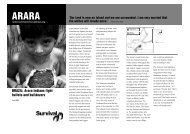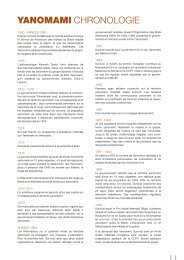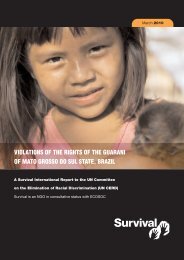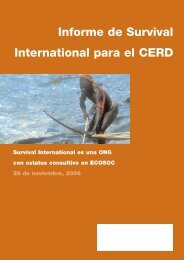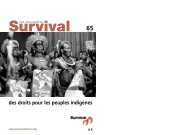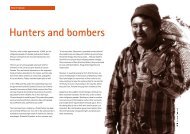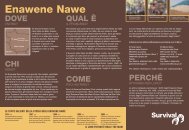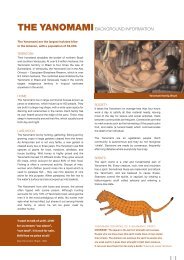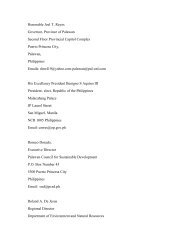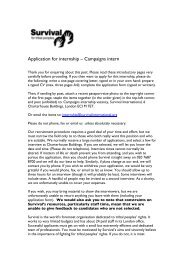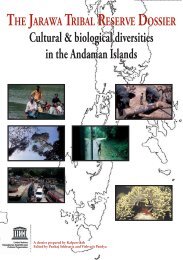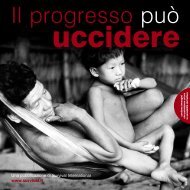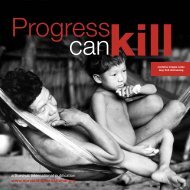Awá – the Campaign - Survival International
Awá – the Campaign - Survival International
Awá – the Campaign - Survival International
Create successful ePaper yourself
Turn your PDF publications into a flip-book with our unique Google optimized e-Paper software.
Awá – <strong>the</strong> <strong>Campaign</strong> <br />
As well as <strong>Survival</strong>, o<strong>the</strong>r organizations have campaigned ei<strong>the</strong>r for <strong>the</strong> Awá <br />
specifically, or all Indians affected by <strong>the</strong> Greater Carajás Project. In Brazil, <strong>the</strong> <br />
Conselho Indigenista Missionario (CIMI) has taken a leading role, toge<strong>the</strong>r with: <strong>the</strong> <br />
indigenous network (COIAB), <strong>the</strong> Commissão Pró-‐Índio de São Paulo, <strong>the</strong> Centro de <br />
Trabalho Indigenista, and <strong>the</strong> Instituto Socioambiental. The Brazilian Indian <br />
Foundation (FUNAI) has pressed for Awá land to be protected. <strong>International</strong>ly, CAFOD <br />
has supported education projects with <strong>the</strong> Awá. <br />
Some of <strong>Survival</strong>’s actions are emboldened (below). <br />
1950s <br />
Invasion of ranchers and loggers following new <br />
BR322 road. <br />
1951-‐1953 <br />
A <strong>Survival</strong> founder, Francis Huxley, works with <br />
<strong>the</strong> Ka’apor tribe, recording accounts of <strong>the</strong>ir <br />
uncontacted Awá neighbours. <br />
1967 <br />
Iron ore found in Carajás hills. <br />
1971 <br />
<strong>Survival</strong> invited by Brazilian government to <br />
report on Indian situation. A <strong>Survival</strong> <br />
founder, Robin Hanbury-‐Tenison, visits Gavião <br />
tribe and reports serious health problems. He <br />
recommends no roads should go through <br />
uncontacted Indians’ territory. <br />
1973-‐76 <br />
FUNAI contact missions. Of 56 individuals <br />
contacted in 1976, over half die within 4 years. <br />
1978 <br />
Gunmen attack uncontacted Awá, killing several <br />
and capturing a boy. His fa<strong>the</strong>r, Karapiru, <br />
escapes and spends 10 years alone until <br />
walking into a Brazilian village. Later, he is <br />
reunited with <strong>the</strong> only o<strong>the</strong>r survivor, his son. <br />
1979 <br />
Group of Awá poisoned by invaders: 7 killed. <br />
1982 <br />
The EC makes its first loan outside Europe, <strong>the</strong> <br />
largest investment in <strong>the</strong> Carajás Project <br />
(US$600 million). <strong>Survival</strong> calls on EC to <br />
reconsider and impose conditions to protect <br />
Indians. Mining giant, CVRD, and FUNAI agree <br />
US$13.6 million grant, demanded by World <br />
Bank as a condition of its US $300 million loan. <br />
Less than 2% given for Indian protection. <br />
1985 <br />
Carajás railway inaugurated, Awá land opened <br />
to colonists and loggers. Working group <br />
recommends 276,000 hectares be demarcated <br />
for Awá. <br />
1987 <br />
<strong>Survival</strong> launches Greater Carajás Project <br />
campaign in UK parliament, publishing, <br />
Bound in Misery and Iron – The Impact of <strong>the</strong> <br />
Grande Carajás Programme on <strong>the</strong> Indians of <br />
Brazil. <strong>Survival</strong> lobbies Brazilian <br />
government, EU and World Bank. <br />
1988 <br />
FUNAI announces 147,500 hectare Awá <br />
territory, less than 60% of recommendation. <br />
CIMI launches campaign, ‘Land for <strong>the</strong> Awá’. <br />
World Bank admits, ‘The Awá are endangered… <br />
as regards <strong>the</strong>ir survival… [including] assault <br />
and murder by non-‐Indians.’ European <br />
Parliament agrees that <strong>the</strong> Awá are endangered <br />
and, ‘little has been done to protect <strong>the</strong> Indian <br />
communities...’ <br />
1989 <br />
<strong>Survival</strong> holds vigils at Brazilian embassies on <br />
Awá and o<strong>the</strong>rs harmed by Carajás Project. <br />
1990 <br />
Manaus meeting of 100 scientists declares Awá <br />
region a conservation priority. <br />
1991 <br />
<strong>Survival</strong> publishes action bulletin, Nomadic <br />
tribe faces extinction. <br />
1992 <br />
<strong>Survival</strong> visits Awá. FUNAI orders <br />
demarcation of Awá land, but a court says a <br />
ranch has right to remain inside. Government
proposes fur<strong>the</strong>r reduction of Awá territory to <br />
118,000 hectares. <br />
1993 <br />
<strong>Survival</strong> publishes action bulletin, <br />
Government inaction condemns Awá, and <br />
successfully lobbies World Bank to make <br />
demarcation of Awá land a condition of its <br />
loan to Brazilian mining company. Railway <br />
blockaded and FUNAI hostages held by Indians, <br />
including Awá. Mining company promises to <br />
fund demarcation. Hostages are released <br />
unharmed. Prof. Terence Turner (later <strong>Survival</strong> <br />
board member) testifies on Awá situation to US <br />
congressional hearing, saying, ‘The Awá face <br />
extinction from <strong>the</strong> invasion of ranchers and <br />
settlers.’ <strong>Survival</strong> calls for demarcation of <br />
Awá territory to <strong>the</strong> UN. Brazil government <br />
responds, stating demarcation will be <br />
finished by November. It isn’t. <br />
1994-‐96 <br />
Prof. William Balée testifies to US Congressional <br />
Committee about destruction faced by Awá and <br />
neighbouring tribes. British MP tables <br />
parliamentary question on demarcation. <br />
<strong>Survival</strong> protests at Brazilian embassies about <br />
plans to reduce Awá and o<strong>the</strong>r Indian <br />
territories, and funds medical work with <strong>the</strong> <br />
Awá and Ka’apor and Tenetehara neighbours. <br />
1999 <br />
Brazilian government lists 240 illegal <br />
occupations of Awá territory. <br />
2000-‐01 <br />
<strong>Survival</strong> visits Awá and publishes urgent <br />
bulletin, Uncontacted Indians face extinction, <br />
<strong>the</strong> book, Disinherited – <strong>the</strong> Indians of Brazil, <br />
which highlights Awá situation and a report <br />
on <strong>the</strong> world’s most vulnerable tribes, including <br />
<strong>the</strong> Awá. It highlights World Bank and EU <br />
broken promises. <br />
2002 <br />
UN special rapporteur highlights Awá case at <br />
Council on Human Rights. <strong>Survival</strong> visits Awá <br />
and publishes urgent bulletin, Brazil <br />
nomads face extinction; supporters send <br />
thousands of letters to a Brazilian judge. <br />
<strong>Survival</strong> advises BBC TV report. <strong>Survival</strong> and <br />
Brazilian organizations launch joint campaign <br />
for land demarcation. Brazilian judge orders <br />
demarcation of Awá territory. <br />
2003 <br />
<strong>Survival</strong> delivers over 40,000 signatures to <br />
Brazilian embassies, urging government to <br />
implement plan to protect Awá area. <br />
2005 <br />
Awa territory registered and ratified on 19 <br />
April, Brazil’s ‘Indian Day’. <br />
2007 <br />
Brazilian anthropologist concludes Awá still <br />
facing genocide. <br />
2009 <br />
FUNAI finds signs of uncontacted Awá in <strong>the</strong> <br />
Araribóia territory. <strong>Survival</strong> publishes urgent <br />
bulletin, Uncontacted tribe faces <br />
annihilation, asking supporters to write to <br />
Judge Madeira to remove invaders. Judge <br />
visits Awá territory saying, ‘We are dealing <br />
with a real genocide.’ He rules all invaders <br />
must leave in 180 days. Ranchers appeal; <strong>the</strong> <br />
ruling is suspended. Illegal logging increases. <br />
Awá territory confirmed highest level of <br />
deforestation of all indigenous territories in <br />
Amazon. Arco de Fogo/Aturawaka Operation <br />
ordered to remove invaders in Awá and <br />
o<strong>the</strong>r indigenous territories. <br />
2010 <br />
Nearly one-‐third of Awá territory now <br />
destroyed. FUNAI reports illegal towns and <br />
roads inside. <strong>Survival</strong> visits Awá. Mayor of <br />
logging town Zé Doca claims tribe does not <br />
exist. Dozens of Awá respond by camping in <br />
front of town hall, and CIMI launches ‘We exist’ <br />
campaign. Awá go to capital to ask for action <br />
from Attorney General. <br />
2011 <br />
FUNAI’s Bruno Fragoso states on TV, ‘If rapid <br />
emergency measures are not taken, <strong>the</strong> future <br />
of this people is extinction.’ <strong>Survival</strong> and 20 <br />
organizations and experts write to <br />
President, urging action. Brazil’s <br />
environment agency closes sawmills and <br />
arrests loggers. <strong>Survival</strong> visits Awá. <br />
2012 <br />
Brazilian TV reports sawmills are only 5 kms <br />
from Awá land; wood is confiscated. Prosecutor <br />
rules invaders must leave Awá territory. <br />
Brazil’s Indian agency says it will maintain a <br />
permanent presence in one Awá area, to ensure <br />
Indian land respected. <br />
<strong>Survival</strong> launches new campaign with <br />
short film and appeal on <strong>the</strong> Awá.



